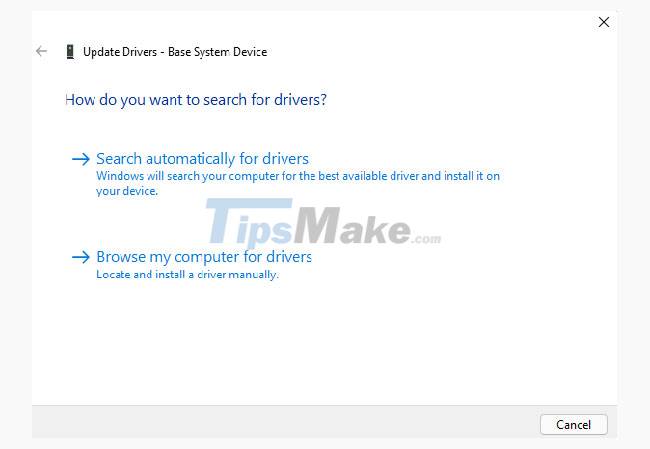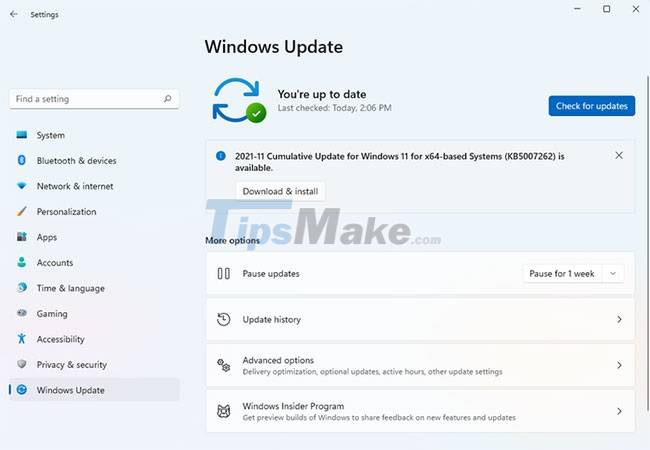How to fix 'Base System Device' error in Device Manager
So what is Base System Device and how can I fix the warning it gives you in Device Manager?
What is Base System Device Error?
The Base System Device is a hardware component that is connected to the PC. For example, it could be a motherboard chipset, a Bluetooth transmitter component, or an SD card reader.
The reason it appears as "Base System Device" is because your system cannot properly interact with the device. This is usually because your computer doesn't have an official device driver to work with.
The Base System Devices that appear on your Device Manager usually have a small yellow exclamation mark and are classified as Other devices.

How to fix Base System Device errors in Device Manager
You can usually fix Base System Device errors by installing the respective device's driver. This then gives the PC something to work with and allows it to communicate with the appropriate device.
1. Install the driver manually from the manufacturer's website
The first place you must visit to download the correct driver from the device manufacturer. You can tell Windows to find the driver for you, but this is most likely caused by Windows not finding anything to download.
If you don't have the original driver disc for your device, try searching online for the device name or device manufacturer. Then, go to the manufacturer's website and download the relevant drivers. For example, if you want to install drivers for your Intel-based chipset, you can use Intel's Chipset Installation Utility.
When you find the appropriate driver, right click on Base System Device from Device Manager and select Update driver. On the following screen, select Browse my computer for drivers and navigate to the folder where you have stored the driver files.

Select them and complete the steps to install.
2. Let Windows find and download the driver
If you want to try the automatic Windows update feature, go to the Update Driver menu as above. However, select Search automatically for drivers instead of Browse my computer for drivers.
Windows will then search for an appropriate driver. If it finds it, you can install the driver by following the setup steps that Windows provides. If not, you can try running Windows Update to see if that helps.

Note that this will identify all available updates to the system. If there are several updates available, you will need to see the list of updates to verify if the driver you are looking for is there.
Hopefully you can determine what the Base System Device is on your PC, find the appropriate driver, and fix the problem.
If the problem can't be fixed, there's likely something wrong with your hardware. You can test using the hardware on another PC. For example, you can plug the SD card into another PC and see if it works fine.
However, if you are having trouble updating or finding the right driver, you may want to try a third-party driver updater.
You should read it
- 6 ways to fix Bluetooth errors not in Device Manager on Windows 10, 8.1, 8, 7, XP, Vista
- How to fix Code 10 errors that prevent the device from booting
- Switch from base 2 to base 16
- Switch from base 16 to base 10
- What is Windows Device Manager? How to use it?
- How to fix 'This Device is Disabled (Code 22)' error on Windows 11
- How to fix error code 43 for NVIDIA or Intel GPUs on Windows
- How to find lost Android devices using Android Device Manager
May be interested
- 9 ways to open Device Manager in Windows 10
 here are 9 methods that you can use to open device manager in windows 10, including using commands, shortcuts and search.
here are 9 methods that you can use to open device manager in windows 10, including using commands, shortcuts and search. - Steps to open Device Manager on Windows
 there are many different ways to access device manager on windows. this article will guide you to open device manager in 4 most common ways.
there are many different ways to access device manager on windows. this article will guide you to open device manager in 4 most common ways. - How to use Device Manager to troubleshoot Windows 10
 in this short guide, tipsmake will help you learn how to use device manager to troubleshoot windows 10 problems.
in this short guide, tipsmake will help you learn how to use device manager to troubleshoot windows 10 problems. - How to fix 'This Device is Disabled (Code 22)' error on Windows 11
 do you encounter the error "this device is disabled (code 22)" when connecting an external device to your computer? this is a common device manager error that prevents you from using the device.
do you encounter the error "this device is disabled (code 22)" when connecting an external device to your computer? this is a common device manager error that prevents you from using the device. - 8 ways to fix 'There Are No Startup Items to Display in the Task Manager' error on Windows
 while using windows task manager, you may suddenly encounter an error message that says 'there are no startup items to display in task manager'. it's a cryptic error message, but don't worry; the repair is very easy.
while using windows task manager, you may suddenly encounter an error message that says 'there are no startup items to display in task manager'. it's a cryptic error message, but don't worry; the repair is very easy. - Quickly download new drivers through Device Manager on Windows 10
 on windows 10, drivers are needed for your device to connect with other devices and the operating system. windows 10 provides a series of default generic drivers for monitors (displays), wireless connections such as bluetooth, keyboards, mice, and other manufacturer-installed hardware.
on windows 10, drivers are needed for your device to connect with other devices and the operating system. windows 10 provides a series of default generic drivers for monitors (displays), wireless connections such as bluetooth, keyboards, mice, and other manufacturer-installed hardware. - How to open Device Manager Windows 11
 opening device manager on windows 11 allows users to check peripheral devices connected to the computer. here is a simple way to open device manager windows 11.
opening device manager on windows 11 allows users to check peripheral devices connected to the computer. here is a simple way to open device manager windows 11. - How to Open Device Manager in Windows
 there will come a time where you will have to take your pc's problems into your own hands. this is a guide on how to access the device manager, a essential utility in windows for repairs and maintenance. right click on the 'start' menu and...
there will come a time where you will have to take your pc's problems into your own hands. this is a guide on how to access the device manager, a essential utility in windows for repairs and maintenance. right click on the 'start' menu and... - Experience the all-new Task Manager in Windows 8
 if you are using windows 8 for the first time, it may take a few minutes to find the task manager system manager. the following article will introduce you to some other ways to start this utility ...
if you are using windows 8 for the first time, it may take a few minutes to find the task manager system manager. the following article will introduce you to some other ways to start this utility ... - Switch from base 2 to base 16
 in mathematics and digital electronics, binary numbers are a number that is represented in the base number 2 system or binary number system, using only two symbols, 0 and 1.
in mathematics and digital electronics, binary numbers are a number that is represented in the base number 2 system or binary number system, using only two symbols, 0 and 1.










 How to fix Dxgmms2.sys xanh Blue Screen error
How to fix Dxgmms2.sys xanh Blue Screen error Steps to Fix Mobile Hotspot not working on Windows 10
Steps to Fix Mobile Hotspot not working on Windows 10 What to do when the Windows Taskbar is frozen, unusable?
What to do when the Windows Taskbar is frozen, unusable? How to fix error 0x800704C8 when Copying files on the computer
How to fix error 0x800704C8 when Copying files on the computer 9 Simplest Ways to Fix Computer Not Receiving Mouse Error
9 Simplest Ways to Fix Computer Not Receiving Mouse Error 7 Most Effective Ways to Fix Laptop Not On Screen
7 Most Effective Ways to Fix Laptop Not On Screen